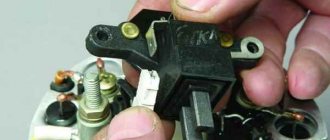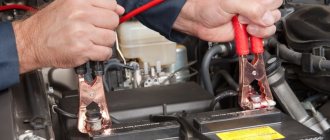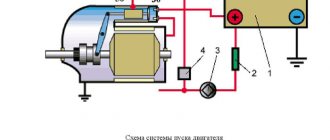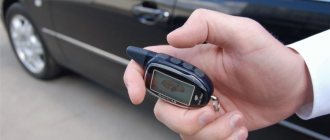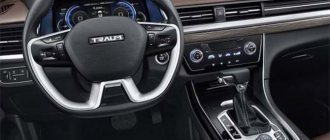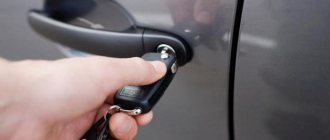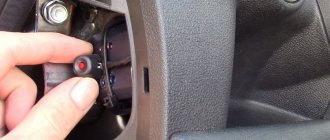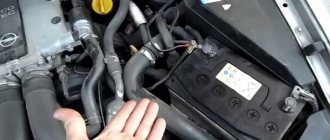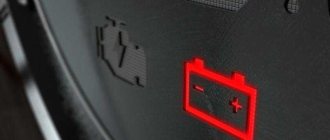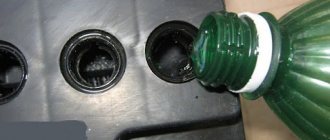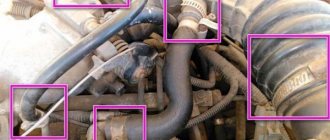Which motorist has not found himself in an unpleasant situation with a dead battery? You open the car, get in, turn on the ignition and... nothing. The battery died and the car became completely useless. Again, look for another car to light the battery or drag it home to recharge. Again, a lot of nerves were spent, being late for work or an important meeting. A familiar situation, isn't it? So, why does the car battery drain so quickly? We will look into this in this article.
Reasons for rapid discharge of a car battery
Sometimes the cause of discharge is the driver’s banal inattention. Before finding out why your car battery discharges quickly, make sure that the headlights, radio, chargers and other consumers were not turned on while parked.
Most often, the reasons for the rapid discharge of the battery in a car lie in malfunctions of the on-board electrical network or the battery itself:
The main reasons for rapid battery discharge and troubleshooting: video
- current leakage due to short circuit;
- malfunction or incorrect connection of a powerful consumer;
- poor contact of the terminals with the battery terminals or ground wires with the body and engine;
- undercharging or overcharging of the battery due to malfunctions of the generator and its “piping”;
- low electrolyte density;
- natural wear and tear of the battery due to age-related degradation.
The prevalence of these reasons depends on the age of both the car and the condition of its battery.
The main reasons for the rapid discharge of an old car battery:
If the voltage measurement at the battery terminals when charging with a generator shows less than 13.9, then the charging current is insufficient
- contamination and decrease in electrolyte density;
- natural wear and sulfation of plates;
- poor contact at the terminals and/or ground connections to the body.
Why does a new battery drain quickly in a car?:
- incorrect operation of the generator (undercharging or overcharging);
- current leakage due to incorrect connection or consumer malfunction;
- poor contact or short circuit in the electrical network.
Old cars with high mileage are more likely to suffer from short circuits due to damaged insulation and oxidation of contacts . This is especially typical for cars with non-standard handicraft electrical equipment.
Why does the battery drain quickly in summer, winter, autumn, spring?
The rate of discharge of a car battery may depend on the time of year , or more precisely on weather conditions - temperature and humidity.
Seasonal reasons for the rapid discharge of car batteries:
| Season | Reason for discharge |
| Spring and autumn | Terminal oxidation due to high humidity |
| Summer |
|
| Winter |
|
How to extend battery life
Finally, just a few recommendations on how to avoid encountering such phenomena.
Recommendations boil down to compliance with the following rules:
- Fully charge the battery with a charger at least once every six months;
- buy electrolyte and distillate in trusted places;
- periodically check the electrical wiring, generator and other electrical equipment;
- monitor the condition of the battery terminals and terminals;
- when oxides and corrosion appear, clean them and lubricate them;
- keep the battery case clean;
- Always monitor the electrolyte level and charge.
Most problems with rapid and sudden battery drain can be resolved. But in some cases there will be no choice but to buy a new battery.
Why does my car battery drain very quickly?
If the battery discharges very quickly (the voltage drops below 10.5 V in a few hours or even dies while driving), there are serious problems with the on-board electrical network .
All the main reasons for the very rapid discharge of a car battery and the malfunctions that caused them are collected in the table.
| The reason for the rapid discharge of the battery | Why does it occur |
| Large current leakage | Battery terminals are oxidized |
| Short circuit of exposed wiring to ground | |
| Powerful consumer left on | |
| Weak contact in the electrical circuit | Terminals are poorly secured |
| Poor ground contact with the body and/or engine | |
| The generator wire is oxidized or coming off | |
| There is no battery charging in the car | The generator has failed or its pulley has been torn off |
| The alternator belt is slipping or broken | |
| Generator excitation fuse blown | |
| Battery malfunction | Electrolyte boiling away |
| Incorrect electrolyte density | |
| Sulfation or shedding of plates | |
| Natural wear and tear of the battery | Loss of capacity due to depleted battery life |
Next, we will analyze the most typical cases of rapid discharge and their causes.
Why does a car battery charge quickly and discharge quickly?
Rapid discharge and charging of the battery indicates a decrease in battery capacity due to one of the following reasons:
- natural wear and tear (battery age is more than 5 years);
- sulfation, destruction or short-circuiting of active plates;
- low electrolyte level and/or density.
What causes the battery to discharge quickly when the ignition is turned off?
A simple method to find the cause of battery discharge when the ignition is turned off: video
The most likely reason for the rapid discharge of a car battery is current leakage caused by:
- wiring short circuit;
- incorrect connection of powerful consumers;
- activity of background consumers that do not switch off due to a fault.
How to find out why the battery quickly discharges when the ignition is turned off, read below.
Why does the battery die after the first start?
The reasons for the rapid discharge of a car battery after starting the engine (one or several cranks of the starter drain the battery) most often lie in its wear (see above) or undercharging. Sometimes the culprit can be loose or oxidized terminals that are leaking a lot of current.
A new car battery discharges quickly - what's the problem?
A new and known good battery most often discharges for the following reasons:
Oxidized terminals are a clear sign of poor contact.
- poor contact of the terminals with the battery terminals or ground with the body;
- malfunction of the generator and/or its relay regulator;
- current leakage in the network.
Why can the battery discharge on the road?
Typically, the battery discharges while driving due to:
- poor contact of terminals or ground wire to the body;
- oxidation or damage to the generator output and its wire;
- generator malfunction;
- lack of generator excitation (the excitation fuse may blow);
- breakdown of the voltage regulator relay;
- a broken generator belt or a broken pulley.
Signaling
When understanding how the battery drains in a particular car, you need to know exactly how the alarm was installed.
With homemade power supply, the battery runs out in a short time, making reliable anti-theft ineffective. Rapid discharge de-energizes the system. Low-quality devices also often lead to the battery dying overnight. An experienced auto electrician will tell you how this happened and explain why it happened. If the battery is dead, you can find the source of the problem yourself. But not everyone can do this competently and understand some cases to the end. Therefore, in some situations it is better to entrust this work to specialists. Return to list
How to find and eliminate the cause of a low car battery
In most cases, a multimeter is enough to determine why the battery is discharging. Universal algorithm for searching for a discharge source:
If the generator produces insufficient charging current, you can install a three-level relay regulator
- Inspect the battery terminals and the contact points of the “-” terminal with the body and engine of the car. If a weak tightening or oxides are detected, clean the contact points, tighten to the recommended torque and lubricate for prevention.
- Check the heating of the terminals and power wires immediately after startup (or during the process). If the wires fail and overheat, replace them with thicker ones, with a cross-section of at least 16 mm².
- Make sure there are no leaks in the battery case. To do this, with the negative terminal removed, connect one probe to the positive terminal of the battery, and the other alternately to different parts of the case. The voltage should be near zero.
- Check the charging voltage at the battery terminals at 2000 rpm, compare with the voltage between the generator terminal (indicated by +, BAT, B, B+, 30) and the body or ground terminal (-, B-, D-, M, E, GND, GRD, 31). If the charge voltage is below 13.8 V or above 14.8 V, find and eliminate the cause of overcharging or undercharging. If the battery receives significantly less (0.5 V or more) than the generator provides at the output, check the contact of its output with the battery, restore tight contact or replace the wire.
- Measure the background current with the ignition off. To do this, you need to turn on the multimeter in the 10 A DC current measurement mode (usually a separate “+” socket for the probe is allocated for this), remove any terminal from the battery and connect one probe to the battery terminal, and the second to the terminal (the polarity of the probes does not matter ). Normally, the consumption at rest should not exceed 100 mA (0.100 A). If more, look for the culprit.
Finding current leakage using a multimeter and current clamps
If during diagnostics a significant current consumption is revealed at rest, we identify the defective circuit in the following way (it is more convenient to carry out this procedure with an assistant):
- We connect a voltmeter into the gap between the terminal and the corresponding battery terminal.
- We remove the fuses one by one from the block in the passenger compartment or in the engine compartment, observing the voltmeter readings. By removing the fuse responsible for the faulty circuit, the leakage current will decrease.
- We consistently inspect the circuit protected by the removed fuse for exposed areas of insulation, short circuits, oxides, ground contacts, and check the devices connected to it.
What to do if the battery drains quickly in your car: diagnosing and troubleshooting problems
| Problem | How to check/identify, diagnose | How to fix the problem |
| Battery dies when starting engine |
|
|
| The battery takes a long time to charge, but runs out quickly |
|
|
| The battery discharges when parked overnight or during the day with the ignition off |
|
|
| New battery drains quickly |
|
|
| The battery runs out on the road |
|
|
Let's sum it up
Unpleasant situations related to the battery during vehicle operation occur virtually all the time. We are talking about troubles with low charge, constant battery discharge, and low quality of accessories sold on the market. There are various options and improvements you can make to your car to improve battery control. But all this does not guarantee the absence of problems. If your alternator belt breaks in the middle of the highway, you will have to put up with the dead battery.
If you don’t want to experience difficulties, you should always properly maintain your car and get maximum reliability in the operation of technical equipment. Change the alternator belt in a timely manner, and always pay attention to the operation of electrical appliances. If you have doubts about the quality of the electrician's work, use the services of a service station and check the operation of the entire circuit. This way you will be able to prevent problems with the battery and the need to buy a new, rather expensive battery. How do you think you can protect yourself from problems with your car battery?
Frequently asked questions from car owners
How to check the battery level in a car?
The car battery should not lose more than 10% of its capacity within two weeks. The activity of charge loss depends on several factors simultaneously. You can check the likelihood of a discharge due to battery wear or the level and quality of the electrolyte by visual inspection. To check the discharge as a result of contamination of the housing or leakage to a parasitic consumer, you need a multimeter. Having set the current measurement mode to 10A, you need to connect the multimeter probes into the gap of the negative terminal of the car, which is attached to the battery terminal. To find out whether the discharge is going to the housing, you will need to set the device to the voltage measurement mode, and hold one probe on the battery terminal, and move the second one along the housing. The higher the value, the faster the battery drains.
Why does my car battery drain?
The fastest time for a car battery to die is when the plates begin to deteriorate, and the active mass sheds, or a short circuit occurs, or a short circuit occurs in the wiring. The battery will drain a little slower if the generator does not charge it or the car makes short trips in the winter.
Radio tape recorder
A regular radio or MP3 player is not capable of significantly discharging the battery. But various stereo music systems with many speakers and connected to each other by finger-thick wires can put a fair amount of wear and tear on the battery. Typically, when the engine is off, these stereos go into standby mode and draw only 1 to 3 milliamps of current per hour. At the same time, there are often cases when they simply “freeze” and do not go into the required standby mode, the reason for which is incorrectly set DIP switches on the amplifier itself. In such cases, they consume several hundred milliamps per hour.
What is leakage current?
A leakage is a situation where current flows unplanned in an electrical circuit. It is ideal when the parameters are zero, but values above 0 do not indicate a problem. All machines are equipped with different systems, including those that are connected to the network and consume energy constantly. Let’s say that when a car is parked, it is not in use, but instead the security systems are functioning. In any case, a small amount of energy leakage is considered normal.
The norm is a value that you can calculate yourself. In passenger cars the average value is 40 mA, but if the car has additional devices, the value increases to 80 mA.
Physical deterioration
Each device has its own operating resource. For serviced power supplies it is less (2-3 years of intensive work), for unmaintained ones it is a little more (3-5 years). After 2-3 years, any battery loses its capacity within 30-45% of its original characteristics, and this process cannot be stopped. So if the battery on your car runs out quickly, just imagine how old it is. Perhaps these are just age-related changes.
But there are techniques to slow down aging:
- try to minimize the number of engine starts, because often we don’t pay attention to this and start the car more often than necessary;
- always remember that to make up for daily losses, you need to travel 10-15 km; if the average distances covered for each trip are smaller, the battery will not be fully charged;
- if possible, always try to maintain the charge at the maximum level, since even in a partially discharged state, sulfation of the plates occurs;
- do not allow the battery to be deeply discharged, and for maintenance-free devices this is like death;
- do not neglect checking the electrolyte level;
- At least once a year, carry out measures aimed at preventing sulfation of the plates. True, for older batteries they are no longer effective.
